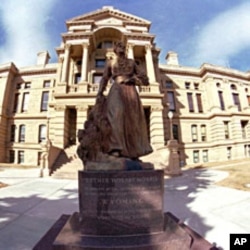The US Feminist Movement
1790 New Jersey grants the vote to "all free inhabitants."
1840 Abolitionists Lucretia Mott and Elizabeth Cady Stanton attend but are barred from participating in the World Anti-Slavery Convention in London.They decide to hold a women's rights convention on their return to America.
1848 During the first women's rights convention in Seneca Falls, New York, Stanton authors the Declaration of Sentiments, which sets the agenda for decades of women's activism.
1853 A suffragist meeting in the Broadway Tabernacle in New York goes down in history as "The Mob Convention," marred by "hissing, yelling, stamping, and all manner of unseemly interruptions."
1869 Wyoming becomes the first U.S. territory to grant unrestricted suffrage to women.
1870 Esther Morris is appointed the justice of the peace of South Pass City, Wyoming, becoming the first female government official. The 15th Amendment is ratified, but women who go to the polls are turned away.
1874 The Supreme Court rules that the 14th Amendment does not grant women the right to vote.
1878 The first federal amendment to grant women the right to vote is introduced in the United States Congress.
1887 The Supreme Court strikes down the law that enfranchised women in the Washington territory. Congress denies women in Utah their right to vote.
1912 Theodore Roosevelt's Progressive (Bull Moose/Republican) Party becomes the first national political party to adopt a woman suffrage plank.
1914 The Senate votes on the "Susan B. Anthony" amendment, which states that no citizen should be denied the right to vote on account of sex, but it does not pass.
1916 Jeannette Rankin of Montana becomes the first American woman elected to represent her state in the U.S. House of Representatives.
1917 The Arkansas legislature's decision to grant women the right to vote in primary, but not general elections results in giving the vote to white women to the exclusion of black women.
1918 President Wilson addresses the Senate in support of the 19th Amendment, but it fails to win the required 2/3 majority of Senate votes.
1919 For a third time, the House votes to enfranchise women. The Senate finally passes the 19th Amendment.
1920 Three quarters of state legislatures ratify the 19th Amendment on 26 August. American women win full voting rights.
1923 The National Woman's Party proposes the Equal Rights Amendment to eliminate gender-based discrimination. It has never been ratified.
Sources: A History of the American Suffragist Movement, National American Women Suffrage Association
















